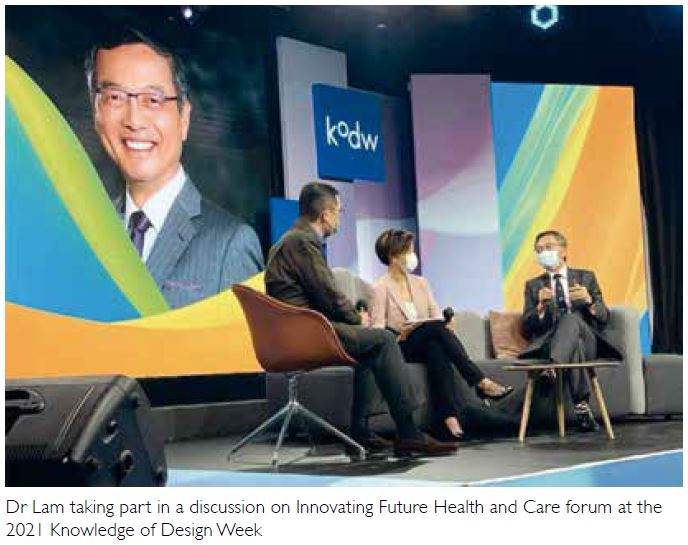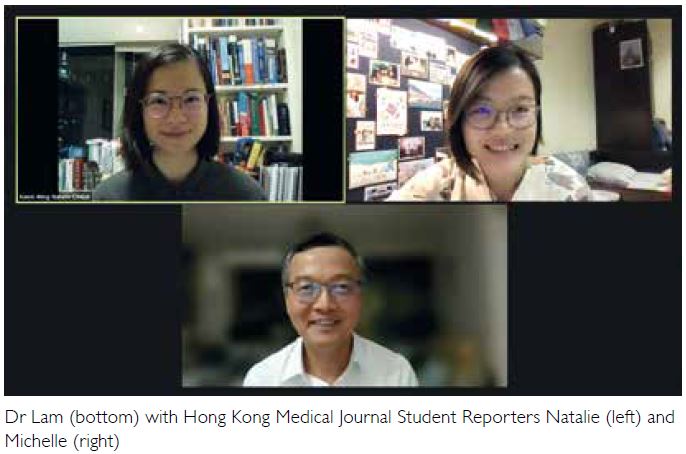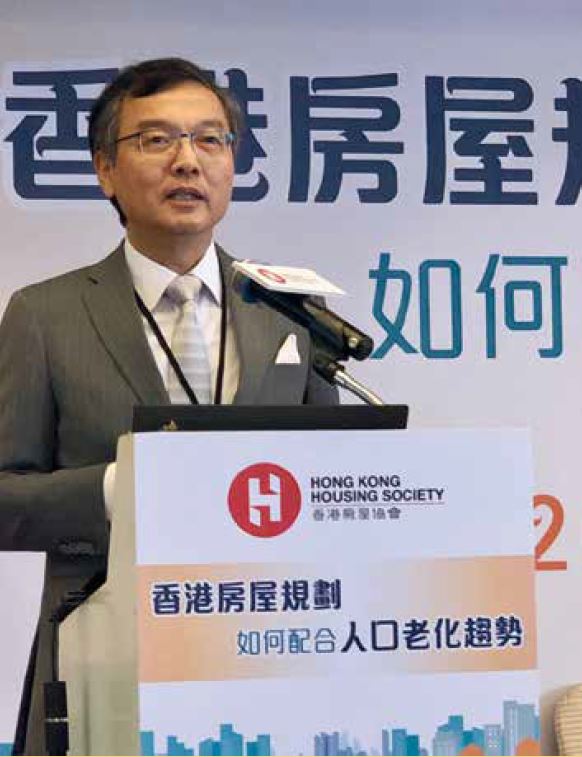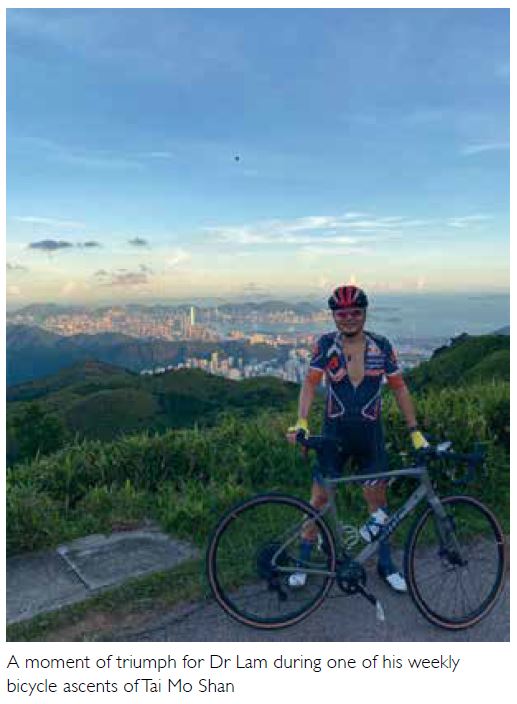© Hong Kong Academy of Medicine. CC BY-NC-ND 4.0
HEALTHCARE FOR SOCIETY
Community health advocate from paediatrics to elderly healthcare: an interview with Dr Ching-choi Lam
Michelle Tsui1, Natalie Cheuk2
1 Year 6 MBChB, The Chinese University of Hong Kong
2 Year 6 MBBS, The University of Hong Kong
Dr Ching-choi Lam, a dual specialist in paediatrics
and community medicine, is a man who wears many
hats. He is the current Chief Executive Officer of
the Haven of Hope Christian Service, a non-official
member of the Executive Council, Chairman of the
Elderly Commission, and Chairman of the Council
for Sustainable Development. Dr Lam has served
two terms as a District Councillor in Sai Kung,
and now advises the Hong Kong SAR Government
on primary healthcare development. In addition
to these varied roles, Dr Lam remains tirelessly
active as a community paediatrician, serving the
underprivileged population in the community clinics
of the Haven of Hope Christian Service.
Dr Lam has engaged in public service
throughout his career, reflecting his ardent desire to
improve the lives of all those in need, from young
children to vulnerable older adults; from patients
in his clinic to the wider public in Hong Kong.
Motivated by concern for those in need outside the
traditional confines of a medical career, Dr Lam has
extended his career into the realm of policy making.
Dr Lam’s dedication to public service was recognised
with a Silver Bauhinia Star in 2019 and he was
appointed as a Justice of the Peace in 2003.
From paediatrician to champion
for elderly health
After graduating from medical school, Dr Lam trained and practised paediatric medicine for many
years before taking up his current role as the CEO
of the Haven of Hope Christian Service. Dr Lam is
often asked about his surprising change in direction
from paediatrics to elderly health care and palliative
care. Although children and elderly people
occupy opposite ends of the age spectrum, in his
eyes, they are both vulnerable populations deserving
of care and attention. Dr Lam traces the beginning of
his work with the elderly to his paediatrics training.
He recalls that while a paediatrics trainee he read
the first chapter of the Textbook of Paediatrics, titled
“Community Paediatrics”. The chapter highlights
the role of the environment in shaping a child’s
development, sparking his belief in the importance
of community work as a means of health promotion.
While promoting the Healthy City Initiative, he
further learnt about the “New Public Health”
concept, which states that effective health promotion
is based on a recognition of the interdependence of
the health of people and the environment. When
the government invited him to join the Elderly
Commission in 2003, he embraced the opportunity
gladly, considering it a natural direction to take.
Applying the art and science of
medicine in the community
One of Dr Lam’s most eminent projects is the
Elderly Service Programme Plan, which proposes a new direction of “Ageing in Place”. In Hong Kong, as
in many other regions of the world with an ageing
population, demand for residential care services for
the elderly is outpacing existing supply. Although
international and local research has demonstrated
the benefits of ageing in place, that is, providing care
for the elderly people at home rather than moving
them to a dedicated residential care facility, the
concept has faced much resistance and even protests
from the Hong Kong community. The government
was accused of proposing this policy to try avoiding
its responsibility to provide adequate residential care
places for the elderly with long-term care needs. In
the face of dissent, Dr Lam sought to understand
more deeply the perspectives of the patients, so he
spent months listening to local older adults through
personal meetings. His research revealed that 80%
of older adults in Hong Kong prefer to age in place.
Dr Lam realised that, despite resistance from many
sectors, most older adults did not object to the
idea and even wished to remain in the community.
Determined that the challenges and worries of the
elderly people should not be ignored, Dr Lam led the
Elderly Commission to formulate the Elderly Services
Programme Plan and proposed strengthening
community care support to boost confidence in
“Ageing in Place” among the elderly people and their
families, and help them see community care as a
desirable alternative to residential care.
Dr Lam rises to confront challenges with
the humble and caring heart of a physician. This
approach, which he also applies to his role as a
community health advocate, strikes a parallel to his
days as a paediatric trainee at the neonatal intensive
care unit at Queen Elizabeth Hospital. At that time,
he often faced the empathic reproval of parents who
had very recently lost their newborn child despite
the best treatment. Dr Lam admits that he often
shed tears, even before the parents, showing them
the depth of his sincerity and his care. Now, when
he is communicating with the elderly protesters, he
evokes their empathy in a similar way. He whole-heartedly
believes that humility and sincerity of spirit speak louder than words, or any objective facts
he may hold. The elderly individuals who attend the
rallies against his policies are often moved by his
sincerity and sometimes reconcile by shaking his
hand and taking photographs together.
Integrity in action as well as belief
One might question how it is possible for a doctor
to fill so many roles. Dr Lam says that, despite rarely
taking a day off from work, he avoids burnout by
maintaining a balanced lifestyle and keeping his
body and mind healthy. As a Christian, Dr Lam
names integrity as one of his core values. He believes in the importance of consistency in one’s professed
beliefs, which bridges the gap between theory and
action. As a doctor, he advocates exercise as a form
of preventive medicine, and he practises what he
preaches; Dr Lam is an enthusiastic recreational
cyclist who covers more than 200 km per week.
In his trans-disciplinary career, Dr Lam brings
medicine from the clinics into the wider community,
demonstrating how to “go beyond”, as he likes to put
it. Ultimately, health is a multidimensional concept.
Applying his range of clinical experience creatively
in his many roles, Dr Lam combines the art and the
science of medicine as a true advocate of community
health.

Figure 3. Dr Lam taking part in a discussion on Innovating Future Health and Care forum at the 2021 Knowledge of Design Week

Figure 4. Dr Lam (bottom) with Hong Kong Medical Journal Student Reporters Natalie (left) and Michelle (right)



